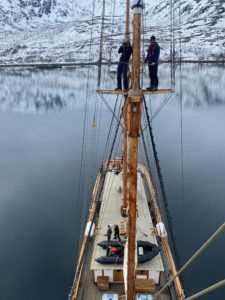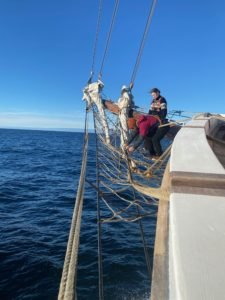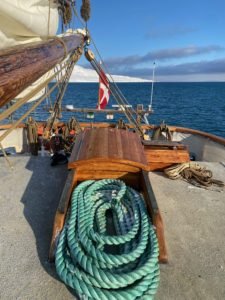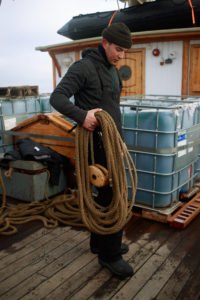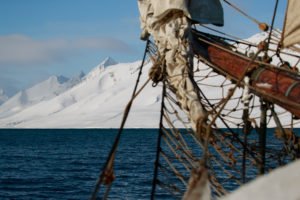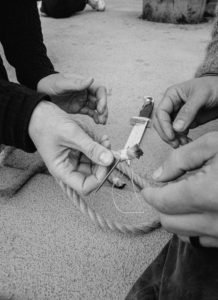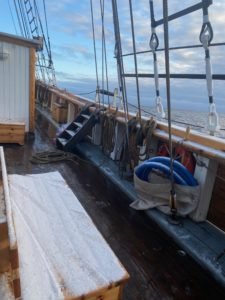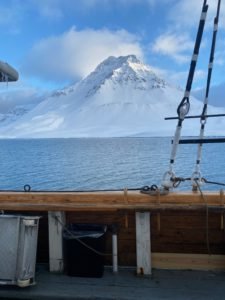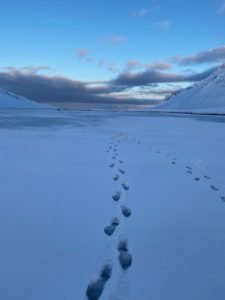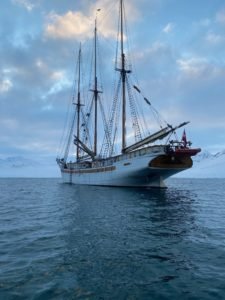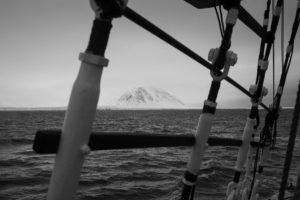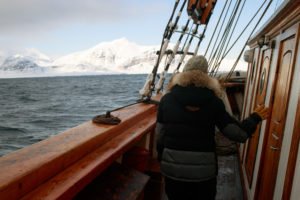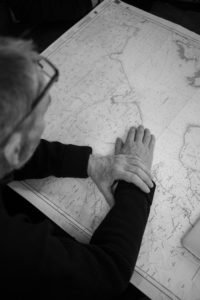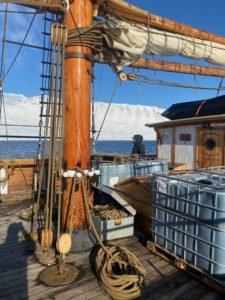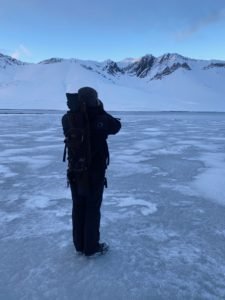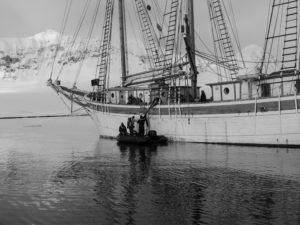Svalbard Expedition II: Crossing the Barents Sea
The original plan called for us to untie from Tromsø harbor on April 18th, but a low pressure system with winds out of the east pinned us in town. As we grouped around the computer Rasmus pointed out the Windy app where the low pressure system moved east, while another blow moved in along the coast of Spitsbergen to the north. We had already decided that Bjornaya, Bear Island, in the middle of the Barents Sea, wasn’t going to happen due to the weather and our course. That was fine. We all agreed that we really just wanted to get there. Save Bjornaya for another time.
We took the extra time tied up to get familiar with the boat, as well as with the mostly-Danish crew – upbeat and able Sofie who always had candy in her pocket, personable and passionate Kot, who used an anarchist symbol for the “O” in her name and lived in treehouses to stop clearcuts, quiet Kaya and An-So (Anna-Sophia) in the galley listening to American hip-hop and whipping up waffle breakfasts, knowledgeable and funny Agnes from Sweden who took issue with my Swedish chef imitations, 23-year-old Siggy who had spent three months learning to hunt seal with the Inuit in Greenland — all of them led by legendary skipper Rasmus Jacobsen.
On the overcast morning of the 19th following breakfast we let loose, leaving town and heading north, our mainmast missing the bridge north of town by a matter of feet. I remained on deck glassing bank farms and boathouses built into the rocky coast. Just south of the entrance into Barents Sea, in a bay ringed by the fishing village of Kvaløyvågen, we dropped the hook and climbed into the rigging to inspect the “nun’s thighs” – the oversized pipe cleaners attached to the wires that stopped lines from getting caught. (Whether they were named so for their girth or hairy nature, Rasmus could not – or would not – say.)
Justin, who trains Marine Special Forces in rock-climbing, promptly lit up a cigar and scurried into the rigging. Down below Jordan snapped photos as Kot and crew taught us how to make up gaskets for the sails, and also gave us a tour of the schooner, main, and mizzen sails, pointing out the gaffs and peaks, the yard-arms, spars, flying jibs and so on by drawing detailed diagrams in chalk on deck. The three Swiss nodded seriously, before announcing that they didn’t even know these words in German – they understood none of this.
The evening of the 19th we climbed into our bunks (which Jordan had taken to calling our “coffins”) groggy with Dramamine, each of us with Scopolamine patches stuck neatly behind our ears, Danish-inflected sailing terminology drying like cod filets in the racks of our heads. As I tried to sleep a line from Barry Lopez’s Arctic Dreams played on repeat in my brain: “In the reprieve at the end of a day, in the stillness of a summer evening, the world sheds its categories, the insistence of its future and is suspended solely in the lilt of its desire.” For the love I couldn’t figure that last clause.
On the cloudless morning of the 20th we pulled anchor and followed a line of tubby fishing boats out of snug harbor into the swell of the Barents Sea. The sun shone brightly, and the gentle swell ushered us along. Danish and English chatter mixed with the clatter of the rigging and the flap of canvas sails as we picked up wind from the northeast. Rasmus had us set a northwest course for 340 degrees. What high hopes we had, sunning on the wooden decks, nary a whitecap in sight! Sea gulls bobbed in our wake like bath toys, dipped in and out of our sails. I regretted my last-minute plunge into the limbo of Dramamine-land. I could feel the edges dropping off objects, while I only wanted to remain conscious enough to glass the factory trawlers on the horizon, the orange flags marking set-nets, and inhale the salt breeze while standing at the helm, becoming one with the compass turning serenely in its liquid.
In hindsight I see that Rasmus understood that time for us was about to disappear – both because of the drugs were fed into our bloodstream, and our entrance into a land where the sun does not set. Thus he organized us into watches – Justin, Jordan and I got the 8-12 pm and 8-12 am shifts, with Kot keep.
Buck Knives, along with Aerial and Voormi, was one of the sponsors of the trip. Following lunch Jordan set a number of knives out for folks to choose. Then he took it upon himself to give the crew knife-sharpening instruction on the poop deck (aft deck, named after la poupe, French for stern). Setting paper on the caprail he drew diagrams of a blade. The girls nodded seriously as he went into a deep dive on the meaning of apex, and how to keep a knife honed. Even as he taught the swell and wind had increased. The bow dipped and rose with a bit more force. A silence fell over our schooner, all of us waiting for the specter of sea sickness to raise its craggy head.
“Thank you guys,” Jordan announced. “Now I’m going to go to the front and throw up.”
And throw up he did. Right onto the back of a passing minke whale and her calf – or maybe just the calf? He said he couldn’t be sure. Definitely onto the back of a whale. Sadly no one was filming that gem.
Lunch was a spectacular chicken curry with cilantro we could tear off the plant. Good news for many of us – we’d get to taste it again. I did what I could to keep my eyes fastened on the horizon and not get dragged down by sweaty nausea, trying not to fixate on memories of fishing in Delaware with my mother and throwing up over the side, or the numerous times on Alaska trollers I lost it. After I found Agnes sitting in a coil of hawser line on the bow with her earpods I did the same, putting on Barry Lopez and never taking my eyes off that band of horizon where the clouds met the sea. Listening to Barry write about the wiles of polar bears, how they smash in seal caves with 45-pound rocks.
For the evening shift just Kot and me showed up. Justin was below in our room shooting Jordan up with Zofran. I checked on J at one point shortly after he threw up in our room. “You don’t want to be in here,” he said gravely. Justin had his needle out. Another of our friends asked Jordan how he was doing, then observed “you know the more I watch the Discovery channel the less I want to go into the world. It’s rough out there.” At the end of our shift I fell asleep to Barry Lopez discussing the finer points of narwhal horns while Jordan slipped into a drug-induced slumber.
I came up the following morning to find Ben passed out in the galley. The boat continued to hike over, chairs sliding about the salon and glasses crashing in the galley. Somehow An-So and Kaya put together a breakfast of porridge. On the plotter I saw we had only made it about halfway to Bear Island – not even a third of the way across Barents. This was beginning to feel like an expedition for realz.
One by one folks dropped, crew and passengers alike. Jordan recovered enough to make the witty joke that every trip should have a BYOPJ policy – bring your own special forces rescue guy so he can give you an IV to replace fluids after you barf your brains out. When someone got sick a rumor of their condition would ripple around the boat. “So and so really isn’t doing too well.”
On the morning of the 21st Jordan made an operatic recovery, banging out some push-ups before going below again to pray to the porcelain god. “The Swiss better be on time,” Justin and I joked. As we steered Kot told me how her parents in Denmark had no patience for her ski-sail lifestyle. She still had belongings at her house, though she had been living in a collective, and in trees to stop clearcutting back in Denmark.
As we approached the second storm system the temperature continued to drop. Justin and I found green onesies that significantly improved the quality of life during our shifts. Rasmus appeared and disappeared, recounting hypnotic stories of his days at sea. Sometimes he stretched out on a foam mat on deck and lay flat to relieve pressure on his back. Time began to be a very unsure concept. We had the sails up, and Rasmus could tell by the sound of their flapping when we steered off-course. He reminded me with his beard, quick wit, wool sweaters and easy smile of a lanky Sean Connery. I never once heard him raise his voice, even when it became clear the exhaust stack had damaged the mizzen sail. The crew looked to him like poet and a sea god combined.
As the heave of the waves increased for our second watch I did what I could to keep my eyes focused on the horizon. Kot described how the Danish government gave students 1k each and paid for school. This led to a discussion on Danish tax code, and how the word for taxes (skat) in Danish also means “my darling.” Then she started feeling badly as the boat wallowed in the troughs, and soon she was feeding the sea. I went down to the cabin for what was starting to become ritual siesta time, a soon-to-be ritual introduced by Justin. Because if you stood vertical you became a much easier target for the seas. Especially if you were inside, and your body’s gyroscope became confused enough to send a message of poisoning. (This strategy of sleeping worked well until Jordan got tossed out of bed by the waves.)
After the nap I woke to what I was sure was breakfast despite the pots containing chili with rice. We started our watch, and of course the sun continued to blaze in the sky. That evening when we went inside I was confused by the cheese and salami Rasmus set out – where was lunch? Then it hit me – I had gotten our watches switched. Time had disappeared completely.
Things took a turn on the morning of the 22nd. In the steady gusts the mizzen and the main sail had each started to rip so they came down immediately. The galley was a mess with broken glass, board games and Uno decks lay strewn about the salon. Boat soup. Perhaps to complement Kaya and An-So served potato soup w rye croutons and bacon for dinner.
Jordan persevered and showed up for watch, heaving on the sails – this was actually starting to feel like real work. To keep in shape we did 100 push-ups on deck with Justin, the effort easy and near-impossible by turns as the deck rose and fell beneath us. “The Swiss better be on time.” This was becoming our favorite joke even though Mark and Andrea and Martina were lovely and had taught me a Swiss card game involving bull heads that I just couldn’t get enough of. As I steered I asked Rasmus if the nun’s thighs were called as much not because they were hairy or substantial but just soft. He tipped his head and said, “You’re really obsessing about this, aren’t you?”
The sea does strange things to your brain.
While we each had our individual obsessions, we all compulsively checked the plotter and radar. As we started nearing Spitsbergen, the southern tip of mainland Svalbard, the weather only worsened. At 340 am we woke to the crash of dishes – more galley salad. And then a glorious thing happened – above a band of clouds we spotted a mountaintop. “LAND AHOY!” Ben yelled. Then Jordan. The seas calmed. We were out of the worst of it.
Then we hit ice.
It started at around 12:30 am, just after our watch ended. Despite our witty remark the Swiss were on time. Bergs of ice loomed higher than the deck. Siggy did what he could to try and find a passage through the band of ice, which was floating west. Back in Tromsø Rasmus had predicted this would happen. He came on deck and used bow-thrusters to avoid the chunks, weaving our 150-foot boat north.
By our morning watch we had made it through. Fog set in. Boats appeared as blue triangles on the radar. By touching on them Rasmus could bring up their size, purpose, destination, and captain. At one point we had two Russian cargo ships and one Russian trawler on the screen. I wanted to get on the radio and try out my Russian. Rasmus advised against it for all the reasons. Visibility was less than a mile. I tried to see with binoculars – and finally made out a white bead of a mast, then port and starboard lights.
“The Russians must have found a way through the ice,” Rasmus observed. If only, I thought.
As we pushed north, it was as if the sea was saving its worst for us. 15-foot waves, with the occasional rogue 20-footer battered the planks. Winds came from the northeast. The long hull hobby-horsed down the wave troughs and then back up the oncoming wave. White streaks moved across the water, as if the wind was clawing at the ocean. Sometimes waves stacked up, the water detonating in a clap of white spray. Green water sloshed over decks. Those of us remaining on deck stared anxiously to the east, eager to be in a bay. A pod of porpoises joined us for a moment, then left us to the seas. Snow started, and we hunkered in our hoods. I had mistakenly hung my green onesie in the hall, and Agnes took it, probably because of my Swedish chef impersonation. It seemed we had similar likes when it came to nooks and clothing.
At the helm we began to wear ski goggles for the snow and freezing rain and spray. The boat timbers creaked as we moved through the sea. We had caught up with the weather system ahead of us.
Finally, on the afternoon of April 23rd we found our way into Isfjorden, and dropped the hook in a small bay on the northern side. We all came out on deck and just stood there, looking around. It felt – how can I explain this? – as if we had traveled through a black hole and come out on the other side into a different, more wondrous universe with black water and turquoise glaciers and bony snow-covered mountains.
Siggy asked if I wanted to go hunt seal. We hooked the black Zodiac up to a boom and lowered it into the water. He took his 6.5 Creedmore. Bearded seal were in season – ringed seal were not. And I have to say it was a good thing. We came across three walrus before pulling the Zodiac onto the sea ice, which apparently only needs to be four centimeters thick to support a person. I didn’t believe it until Siggy hopped on with no problem. He spotted a ringed seal – looking right back at us, curious, blinking with his black marble eyes, disappearing then coming back again to see what the all the action was about. I’m not sure I could shoot a ringed seal, in season or not. They’re pretty cute creatures. Bearded seal – I could blast away, no problem.
Siggy pointed to a crumbling glacier in the back of the bay. “That’s where all the polar bears are,” he said. It truly felt like another universe. Completely uninhabited, not a structure in sight, the sea ice pocked with holes where seal came up for breath.
That evening there was celebration as we bobbed easily on the hook. Drinks came out. The storm and our vomiting had bonded us. We had come through. Now we ate heartily to replace everything we had given back to the sea. Instead of focusing on the moment, trying to convince our bodies to keep down food, we looked ahead to the upcoming week and discussed what we wanted to do. Rasmus brought us together to have a chat about the days ahead.
The Americans all agreed that they wanted to see Pyramiden, the Soviet-era coal mine, even if it meant a hike across sea ice, and perhaps getting eaten by polar bear. The Swiss huddled and murmured in German, then announced in monotone that they were also passionate about Pyramiden.
We agreed that it made sense to ski the following day, and perhaps the next depending on weather – but the main goal would be traveling to Pyramiden. I had been told by a Dutch friend to stay away from the Russian coal-mining town of Barentsburg, which was actually visible from our baby – a long black plume of smoke rose up from the brick chimney across the bay – because folks in Longyearbyen wouldn’t allow us to stop there if we messed with the Russians. He said nothing about Pyramiden. Even if we had to ski six miles in we said it would be worth it. Rasmus warned that there might be no one there – or perhaps only a guard who wouldn’t be able to accomodate us.
The following day we woke to a gorgeous, sunlit day. Everyone was rejuvenated, and we geared up on deck with skins and ski cramp-ons, flare guns and .308s for the polar bears. Here we were, in the Norwegian Arctic, roping up with harnesses to ski Svalbard. Ready for what the next seven days had in store.
Or so we thought. Little did we know what lay in store.

